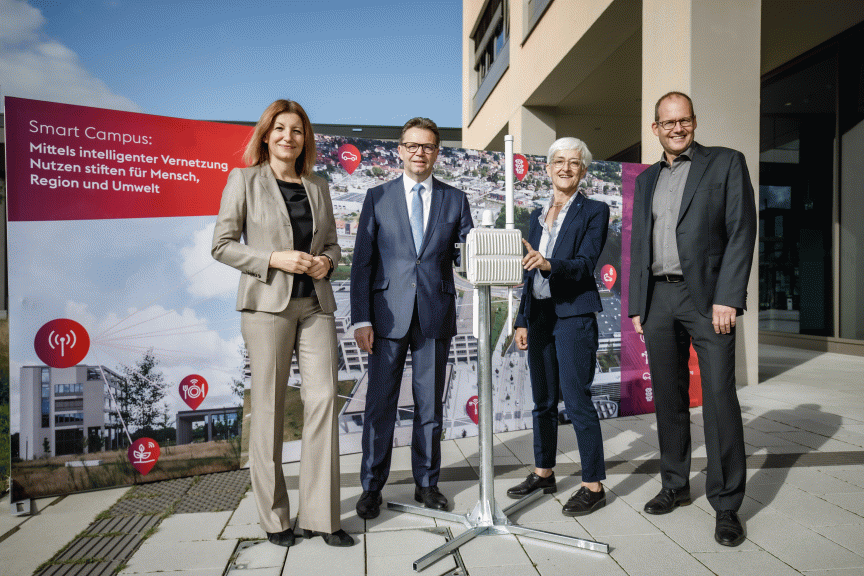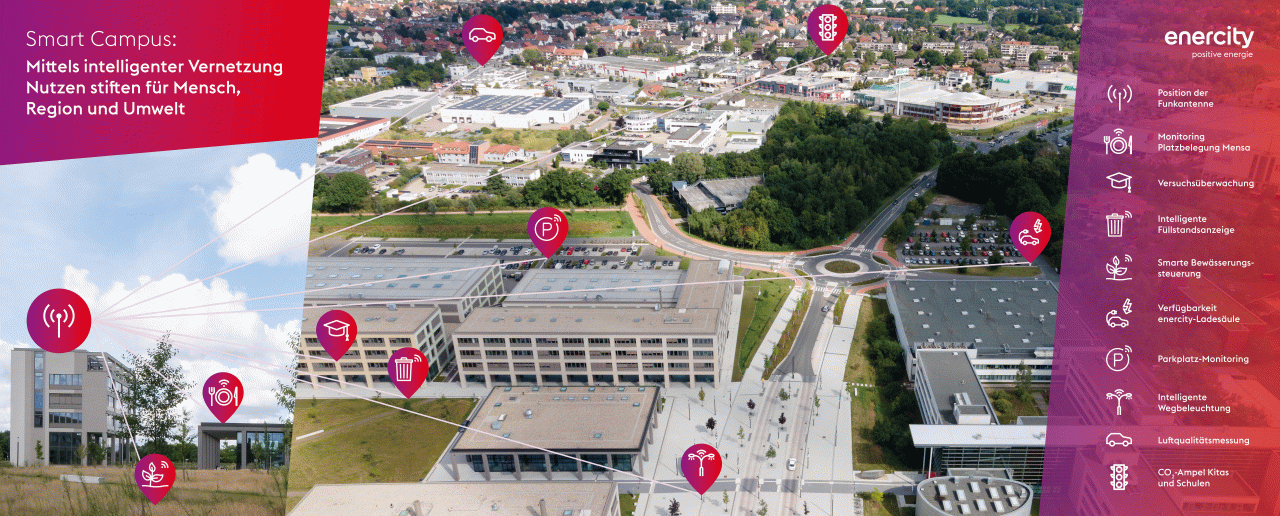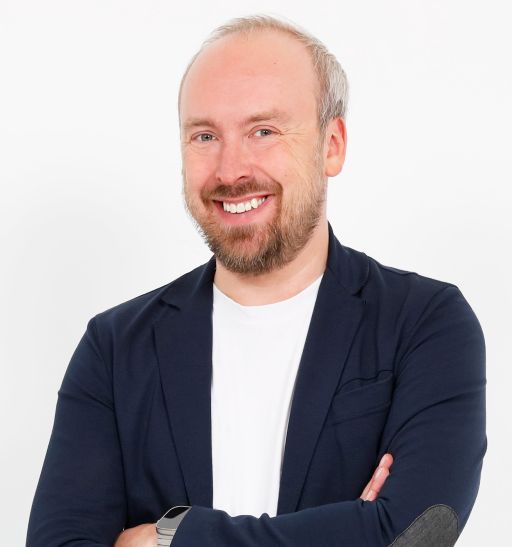The university that thinks for itself: Leibniz Universität Hannover receives intelligent wireless network
 Enercity
Enercity Energy comes almost exclusively from renewable sources. Many small, decentralized power plants, which feed electricity and heat into the grid or store it as required, have replaced large conventional plants. Photovoltaics, heat pumps and battery storage are everywhere. Residential buildings, industry, schools, universities and research institutions are thinking ahead and are networked.
In the lecture hall or laboratory, intelligent services detect the room status (temperature, humidity, CO2 content) in real time. If necessary, staff are notified digitally so that they can intervene. Access to certain areas is controlled automatically. This and much more is part of the vision of the "smart city" or "smart region", the intelligent region of tomorrow and beyond.
A central piece of the puzzle for implementing this vision can now be found on the mechanical engineering campus of Leibniz Universität Hannover (LUH) in Garbsen. enercity has installed a special long-range radio network there in cooperation with the Hannover Region Economic Development Agency, which enables smart services in the Internet of Things (IoT).
The LoRaWAN (Long Range Wide Area Network) radio technology used consists of a large antenna, the so-called IoT gateway. Mounted on the roof of a building, the gateway receives data from electronic probes, better known as sensors, which can record the status of a large number of "things" on the campus. The status data is processed with the help of IoT software and forms the basis for useful services.
Researching engineers at the Institute of Multiphase Processes (IMP) benefit specifically from the production of implants using "electrospinning". The use of these implants for the treatment of chronic shoulder injuries is currently being investigated as part of a research group (FOR2180) of the German Research Foundation, DFG. Fiber-based scaffold structures are produced from polymer solutions. These are then coated with active substances and growth factors and enable regeneration of the body's own tendon tissue after implantation.
The manufacturing process and therefore the quality of the implant are heavily dependent on the climatic conditions in production facilities. This is why the new IoT solution from enercity monitors and documents the temperature and humidity of the test set-up in the laboratory. If the measurement data deviates from preset target ranges, the research team is notified immediately and can intervene.
Even when moving from one laboratory room to another, there is no need for a costly reorganization of the experimental setup. The wireless network moves with them, enabling practically comprehensive coverage of the entire area. This makes processes safer, simpler and more efficient.
 Enercity
Enercity But even more is possible in the future. The interaction of sensors, software and services can help to determine environmental data such as temperature, air and soil moisture, carbon dioxide, volume, brightness or wind strength. Users can also use smart data for real-time monitoring of conditions (parking lot occupancy), for alerts in the event of certain events such as access, exceeding temperatures or water levels and for evaluating and thus optimizing service activities, such as emptying waste garbage cans as soon as they are full. The Internet of Things also makes it possible to control devices and systems such as heating, ventilation, irrigation systems and parking guidance systems.
Another advantage of LoRa wireless technology is that the sensors used are particularly energy-efficient and can therefore be operated for years on a single battery. They do not require a separate power supply or power supply units, making installation simple and affordable.
And: No third party can access transmitted data, as data transmission is encrypted from start to finish in accordance with the latest security standards. enercity is convinced of the future viability of LoRa radio technology and is therefore gradually building up a comprehensive digital infrastructure in the city and region.
The town of Laatzen, for example, is already connected via an antenna on the town hall in order to improve corona ventilation concepts in surrounding schools via networked CO2 traffic lights. Further projects have already been agreed and will be announced shortly.
Improving the competitiveness of the economic region for local companies is one of the central focus areas of Hannover Region's economic development. This also includes the development and promotion of innovative infrastructure projects. The cooperation between enercity and the Hannover Region arose from the shared vision of a smart future for the city and region.
The networking of sensors via LoRaWAN, for example for traffic or environmental data, not only offers potential for companies, but also for municipal services that could also be offered to citizens in the future. For this reason, a pilot project has been launched at LUH's new Campus Maschinenbau Garbsen (CMG). Innovative use cases were identified at the IMP in collaboration with the Hanover region's business development agency. These are now being implemented step by step with the help of enercity.
Prof. Dr. Volker Epping, President of Leibniz Universität Hannover:
"I am delighted about this cooperation, which brings real added value to our campus in Garbsen. Supporting research success through digital processes and testing possibilities and opportunities together with our scientists on campus in a pilot project means real benefits for all sides. It brings about action that is characterized by innovation and the joint leveraging of potential."
Ulf-Birger Franz, Regional Councillor and Head of Economic Affairs, Transport and Education in the Hannover Region:
"As a business and science location, Hannover is very keen to drive forward smart city solutions. The aim is always to make life in the Hannover Region more efficient, more pleasant and more environmentally friendly. Sensor systems such as LoRaWAN can help with this - for example, checking whether the doors and windows on the factory premises are really closed or how high the CO2 levels in the conference room are at the moment. As the Hannover Region, we are happy to help create the infrastructure for this."
Prof. Prof. h.c. Dr.-Ing. Birgit Glasmacher, M.Sc. Head of the Institute of Multiphase Processes (IMP):
"We have wanted a technology with the possibilities that LoRaWAN offers for a long time. I am delighted that together we have managed to set up a corresponding gateway here on our new mechanical engineering campus. Now it's time to integrate this technology into our everyday research in medical technology and process engineering. My institute will be actively involved in making LoRaWAN accessible to the entire mechanical engineering campus and thus optimizing research processes."
Dr. Susanna Zapreva, Chairwoman of the Executive Board of enercity AG:
"Connected cities and regions create sustainable benefits for the people who live there. With our smart solutions in the energy sector, local transport, hospitals, schools and daycare centers, we are already improving the quality of life in public and private spaces. I am delighted that our collaboration with the Hannover Region and Leibniz Universität Hannover at the Unicampus Garbsen also enables us to make a substantial contribution to a smart society in a scientific environment."
Contact us
Tim Mittelstaedt
Hanover Region
Economic Development
Department of Economic Development and Employment Promotion

